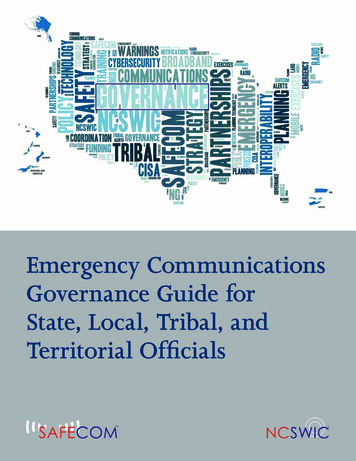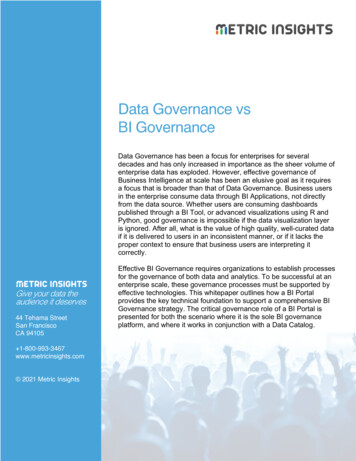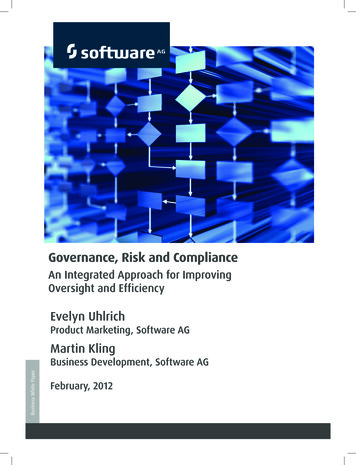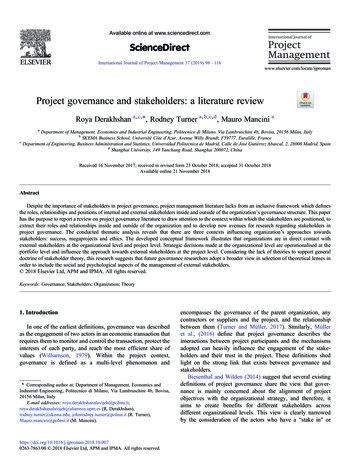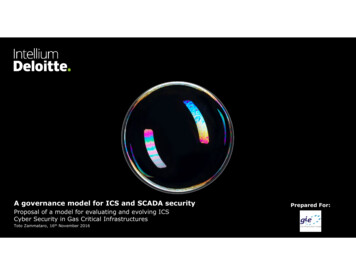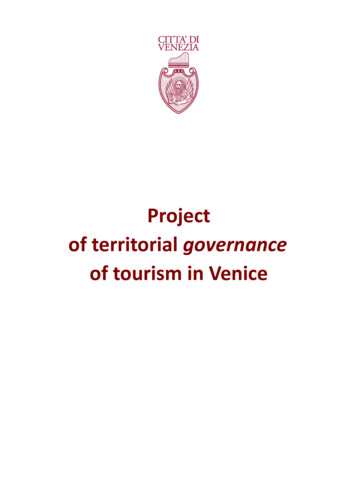
Transcription
Projectof territorial governanceof tourism in Venice
Project of territorial governance of tourism in Venice2
Project of territorial governance of tourism in VeniceTable of ContentsFOREWORD.7FIRST PART:.11THE START OF A PARTICIPATORY ROUTE.111. The functions of tourism and the regulatory framework.132. Tourism in Venice.153. The resident population.224. The stages of the participatory route.255. Principal mission statements of the projects presented and adopted by the Technical Working Group.27SECOND PART:.43OPERATIONAL PROJECT.431. The strategy of the municipality of Venice towards an integrated governance of the resource of tourism.45A) MANAGE THE RESOURCES .49A. Manage the tourism resource.51A.1 Direction Centre: understand the resource for the purpose of planning choices.52A.2 Smart Control Room.52A.3 Monitor and control the entrance points and mobility within the city, also to make it safer.54A.4 To coordinate the functions of control and security.56A.5 New strategies of urban and metropolitan mobility.59A.5.1 Systems of widespread accessibility for the City of Venice and for the Mainland as far theMetropolitan area.60The Venezia Metropolitana 24 ticket.62BUS – Quota application.62Non-scheduled public transport – diversification of landing sites.63A.5.2 Proposal for the establishment of tourist hubs.64A.5.3 Proposal to modify the public navigation service.65San Giobbe.66San Basilio.67A.6 Testing the booking system for access to the Marciana area.68A.7 Booking systems and tourist and cards.73A.8Interventions in support of tourist guide professions to enhance the cultural offer.75A.9Regulating measures for luggage porters.78B) PROTECTING RESIDENTS.81PROVISIONS FOR RESIDENTS.81B. Action plan for residents.83B.1 Revision of Town Planning Rules concerning residents.85B.2 Revision of legislation on tourist locations: solicitation.88B.3 Limiting takeaway.94B.4 Reallocation of public land usage.95B.5 Measures for reform operations of the Special Legislation for Venice.96B.6 Accessibility modifications and overcoming architectural barriers.101B.7 Recycling operations and measures aimed at the containment of loads of waste produced in the City, andthe safeguarding of public hygiene and urban decorum .103C) BALANCING THE EXTRA COSTS TO ENHANCE THE VALORIZATION AND DEVELOPMENT OF THE CITY.109C. The sustainability of the touristic flow in the territory.111C.1 Adopt financial politics for the sustainability of the touristic flow in the territory.113C.2. Proportionality of the tourist tax at holiday rental units.114C.3 Review of Tourist Tax collection method.117C.4 Study for the feasibility of agreements with railway transport operators.118D) INNOVATE COMMUNICATIONS AND MARKETING. EDUCATE TOWARDS RESPONSIBLE AND SUSTAINABLETOURISM.121D. Innovate communications and marketing. Educate towards responsible and sustainable tourism.123D.1 International year of sustainable tourism 2017.124D.2 Improving the quality of what is on offer to tourists in the metropolitan area.125D.3 Signage and information totems.132D.4 A Forts network.137D.5 Network of UNESCO sites in the Veneto region.140D.6 Projects of cultural significance on the mainland.142PART THREE: FIRST STEPS TO TACKLE THE CRITICAL ISSUE OF TOURIST FLOWS.145SUMMER 2017.1.Analysis of historical data for the reference year 2016 – Tourist Bulletin.1472.First actions: Summer 2017.1503
Project of territorial governance of tourism in VeniceMonitoring and controlling access and movements within the city also to improve its safety.150Coordination of Control and Security Functions.151Review of Local Police Rules . . 152Actions to contrast sea waves and to ensure safety of water movements . 153Actions in support of residents.154Innovating information and marketing General objective: educating for a responsible and sustainabletourism.155Behavioural guidelines for visitors, international awareness campaign.156Finding rest areas and mapping gardens and parks of the City of Venice and increasing public sanitaryfacilities, also with innovative technology (self-cleaning WC).1594
Project of territorial governance of tourism in Venice5
Project of territorial governance of tourism in Venice6
Project of territorial governance of tourism in VeniceFOREWORDThe present document arose from the will and commitment of the MunicipalAdministration of Venice, led by the mayor Luigi Brugnaro, to identify within thecompetences and functions of the territorial authority, which represents thecommunity, protects its interests and promotes its development, a project ofcomprehensive governance for the whole city.The site ‘Venice and its Lagoon’ has been inscribed on the UNESCO World HeritageList in 1987 in UNESCO’s World Heritage List for the unique and singular nature of itscultural wealth, consisting of its historical, archaeological, urban, architectural andartistic heritage and of exceptional traditions, integrated into an environmental,natural and landscape context that is unique in the world. The Venice Lagoon is oneof the oldest and most complex examples of the relationships between humanactivities and the forces of nature, in which is found the greatest concentration ofmaterial cultural goods and artistic expression, stratified in centuries of history.It is precisely this exceptional historical identity that has transformed Venice intoone of the international capitals of tourism.This document gathers the results of complex work carried out by the TechnicalGroup established by the Secretary General on the 7th of October 2016, through aparticipatory route that began with the presentation between October 2016 andFebruary 2017 in Council Committee VI jointly with Committees IV, and IX, ofproject proposals presented by the trade associations, experts and workers in thesector, and ordinary citizens.The proposals were subsequently analysed and evaluated by the Working Group:many of the ideas put forward in this document are the result of listening to theseproposals, others come from the Working Group itself, and many others werealready being designed by the Administration.This work follows Municipality resolution no. 91 of the 27th April 2017, which statesthe broad lines for the short and medium terms of the territorial governance oftourism in Venice. The document is based upon a vision inspired by threeprinciples:1 - innovation;2 - sustainability;3 – the promotion of what the Venetian territory has to offer culturally.Tourism in Venice constitutes one of the principal resources of the city. However, itis not just that: it also represents, even with all of the critical situation caused overthe last years by its harmful scale, a social resource for the development of thecommunity. Tourism constitutes an endless source of cultural change, anopportunity for economic growth fro the city and for the entire urban territory.We believe that Venice can innovate itself by means of a sustainable tourism withthe aim of fully using its urban scale, with respect to its authenticity anduniqueness, sharing it with the world in being a World Heritage Site.7
Project of territorial governance of tourism in VeniceWe think that management shared among the different stakeholders will establishgrowth for the whole urban territory. The fragility of the historical moment in whichwe are living should and can become for all involved, public and private, local andinternational, a great occasion for change.The technological and digital evolution has accelerated and led the growth in theflood of tourists, which inadequately controlled has developed in a spontaneous andsometimes uncontrolled way, creating unease for the resident population, for thetourists themselves and arousing the concerns of the Committee for World HeritageSites. We believe, first, that the same levers of digital and technological revolutionthat have led to the risk of deterioration should now be used to control thephenomenon.The actions to be put in place are many and begin from the most urgent, that is, theintensification of territorial controls by the stakeholders or identifiable parties in theshort term, to the dissemination of information and awareness of behaviour thatrespects the urban propriety, passing through measures on the organization ofoffering attractive and distinctive products that are typical of Venice and herterritory, until moving towards useful innovative technological solutions forreserving the goods and services on offer as well as management of the touristphenomenon integrated with urban planning policies and urban mobility.Finally, the governance of tourism in today’s contemporary context, threatenedwith dangers well beyond the competence of a local authority, must be able tooperate in conditions of security through effective controls to be agreed andshared with the other competent institutions.The document is structured in THREE PARTS.The FIRST PART, after a brief foreword on the competencies of the Council in themanagement of tourism and an analysis of the context of the phenomenon inVenice, examines the participatory route initiated in October 2016 in the CouncilCommittee VI, VIII and IX hearings of the 23 proposals, presented and illustratedwith a table summarising the main outcomes of the project proposals and theactions necessary to achieve them. In the analysis the link is also made to thestrategy of the Destination Management Plan (DMP), developed by the Organizationof Tourist Destination Management (OGD: Organizzazione di Gestione dellaDestinazione turistica) entitled ‘Venice’, forwarded to the Veneto Region in October2016 for subsequent actions.The SECOND PART of the document illustrated a project proposal reworked by theTechnical Group nominated by the Secretary General following the outcomes of thehearings from February 2017. This proposal is structured as a document ofprogramming of general objectives; for several specific aims it also represents afirst indication of a pre-operative character through division into actions and timelines. The strategy responds to the end purpose already identified in theAdministration Guidelines 2015-2010, invoked at point 10.1.1: ‘Control the touristflow to make it compatible with the daily life of the resident citizens, restructure thevisitor’s tax and also attack its evasion, and organise services and transport to avoid8
Project of territorial governance of tourism in Venicecongestion, creating new routes.’ Within this strategic vision four general objectivesare identified, each of which is subdivided into specific objectives and relatedactions.GENERAL OBJECTIVEA) Management of resourcesB) Protection of residencyC) Budget for extra costs to allow the use anddevelopment of the cityD) Innovations in information and marketing, tocultivate a responsible and sustainable tourismSPECIFIC OBJECTIVEDirection Centre: understand the resource for thepurpose of planning choicesSmart Control RoomMonitor and control the entrance points and mobilityinside the city, also to make it saferCoordinate the functions of control and securityNew strategies of urban and metropolitan mobilityExperimentation of systems of reservation to the areaaround St Mark’sSystems of reservation and tourist cardsMeasures to support a body of tourist guides to Venicewith a view to using the value of the cultural offeringMeasures of regulation for luggage-handlersRevision of town-planning rules in favour of residence:requestRevision of regulations on tourist locations: requestLimitation to take-away activitiesReorganization of areas of occupation at ground levelRequest for reform measures of Special Legislation forVeniceMeasures for accessibility and overcoming architecturalbarriersThe sustainability of the tourist flow on the territoryProportionality of the visitor’s tax to tourist locationsRevision of the method of collecting the visitor’s taxStudy for the feasibility of agreement with railtransport managementsThe International Year of Sustainable Tourism 2017Improve the quality of the tourist urban offeringPocket handbook for the visitor, Internationalawareness campaignPoster art and information columnsIdentification of areas of restoration and mapping ofthe gardens and parks of the city of Venice and anincrease in public lavatoriesStrong online networksNetworks of the Unesco Veneto siteMeasures of cultural importance on the MainlandMaking use of circuits of popular visits – Slow TourismProjectThe THIRD PART of the document offers an overview of the major lines of actionthat the Administration is already preparing to initiate from the summer 2017 toaddress the critical situation linked to the seasonality of the tourist flow.9
Project of territorial governance of tourism in Venice10
Project of territorial governance of tourism in VeniceFIRST PART:THE START OF A PARTICIPATIVE ROUTELAUNCH OF APARTICIPATORY ROUTE11
Project of territorial governance of tourism in Venice12
Project of territorial governance of tourism in Venice1. The functions of tourism and the regulatory frameworkTourism, from the viewpoint of Council competencies, being directed towards thecultural growth of the individual apart from the exchange of goods and services,represents a complex subject involving important constitutional rights, which are: theright to health, to liberty of movement in the national territory, to free economicinitiative and to the fundamental principals of the legal system, which are those ofsocial integration and the cultural development of society as a whole.It follows from this that to address in an efficient way the complexities of thequestions that the argument puts forward, all the components of the territoryaffected by the tourist phenomenon are going to be involved.In the case of an extraordinary city like Venice, set in a geomorphological context thatis unique in the world, this transversal nature implies that any plan whatsoever of themanagement of the tourist phenomenon must involve the different areas of territorialcompetencies, that is, the security and control of the territory, town planning,residence, the environment, commerce, mobility, the information system andcommunication.The regulation of tourism, after the change made in 2001 to section V of theConstitution, now falls within the responsibility of the Regions (art. 117, paragraph 4of the Constitution).However, from the point when this reform came into effect, numerous ConstitutionalCourt Pronouncements have been made to clarify the boundaries of the division ofresponsibility between the State and the Regions.The Constitutional Court has affirmed the legitimacy of the state regulations whichlegislate respectively in:a) matters, apparently only related to tourism, but in fact linked to different, butconnected, areas. This concerns matters entrusted expressly to the competenceof the State, sole or shared, that present profiles of connection or overlap withthe matter of tourism. In particular, it marks the protection of competition,international relationships and relationships with the EU, protection of theenvironment and cultural heritage, as well as shared competencies relating toprofessions, government of the territory (including town planning and building),and the great networks of transport and navigation;b) matters referring to tourism but which require a state measure that will ensurelegitimate needs for making the best use of this sector, at both an internal andinternational level, with the aim of uniting the great variety offered to Italiantourism.In particular, following the guidelines of the Constitutional Court, even the mostample regional competence does not however exclude a priori the possibility, throughthe law of the state, of assigning administrative functions at a central level andregulating their operation, on the basis of the principles of subsidiarity,appropriateness and differentiation (art. 118 Constitution).A first element common to all the regional administrative systems is the nature of the13
Project of territorial governance of tourism in Veniceadministrative functions retained in the Regions’ control, which can be summarised asfollows:programming of the important annual programmes of implementation of all initiativesand coordination of the activities of different players in the territory, generally bymeans of the adoption of a triennial plans of tourist development;promotion of the unified image of the Region to Italy and abroad, also by means ofinternational relationships;financing of projects of regional development and their selection (recognition of localtourist systems and similar), providing incentives for workers in the sector;coordination of the gathering, development and dissemination of information on thedemand and supply of regional tourism.A second constant of all the regional laws if represented by the recognition of thecentral role of the Council in the promotion of integrated systems of tourist supplyand the creation of public-private cooperation networks.The Veneto Region with the Law no. 11 of 2013 entitled ‘Development andsustainability of Veneto tourism’ legislated for innovating regulation and introducing inart. 9 the role of the Organisation of Tourist Destination Management.In the case of the territory of Venice and the Lagoon, being a unique destination in themeaning of the following article 11, the Organisation of Management is also unique.The function of the Organisation is directed towards creating synergies and forms ofcooperation in management between public and private stakeholders in thedevelopment of tourist products, with the aim of strengthening the supply systemthrough unified management of the functions of provision of information, touristwelcome, and promotion and commercialisation of the destination’s tourist products.The management organisation includes, in addition to the Municipality of Venice, thefollowing bodies: ABBAV, AEPE, AVA, AVM, CCIAA, Confartigianato, Confesercenti,Confcommercio Metropolitana di Venezia, Confindustria, Fondazione Muve, Vela andVeritas. The Organisation has developed as its first official act the DestinationManagement Plan 2016-18, which gives a framework of analysis of the destination,and the strategies and actions to be implemented. As regards the management of thetourist influx, this document refers to the development of the project proposal thatwill be developed by the Municipality of Venice in accordance with the participatoryroute launched by the Council Committee.In addition, it should be mentioned that the municipal functions in the matter oftourism acquire added importance if read in conjunction with the relevant municipaladministrative competencies in:a) urban planning and building;b) commerce and the operation of accommodation facilities;c) making the best use of the cultural heritage and of the promotion andorganisation of cultural activities;d) local police and control;e) mobility and transport.14
Project of territorial governance of tourism in Venice2. Tourism in VeniceThe Destination Management Plan (DMP), cited above, offers an updated analysis ofthe context to which this Working Group referred as the precondition of the project’sdevelopment. Tourism in the Veneto Region, and in particular in Venice, is in a state ofconstant growth. Venice is one of the main Italian cities, with a population of 260,000inhabitants, and constitutes one of the principal tourist targets in the world, with anestimated 24,000,000 visitors a year. (1)The Municipality of Venice is characterised by singular complexities linked in aparticular way to its territorial articulation. The historic centre of Venice, while havinga limited number of inhabitants, faces in many ways the typical problems of the greatmetropolitan centres of the world, playing host to cultural, political and economicevents of national and international importance. There are, besides, peculiaritiesderiving from the characteristic morphologies of the historic city, as the city of water,characterised by unique regulations in matters of town planning, environment, waterand port traffic.The Venetian Mainland, on the other hand, presents all the critical situationsconnected to a great Italian city, accentuated in the last years by an importantindustrial crisis which has accelerated the long decline in productivity in the industrialhub of Porto Maghera: since the nineteen-seventies it has contributed to the loss ofalmost 30,000 jobs, partly replaced by the development of the service and logisticsindustries. Finally, it should not be forgotten that Venice has the third internationalairport, with almost 9.6 passengers per year, two railway stations, and Italy’s secondcruiseship harbour.On the side of demand it is necessary to distinguish between the metropolitanterritory and the City of Venice.Metropolitan territoryMetropolitanCity ofVeniceIn ,0028,798,6776,663,2622,135,4158,798,677% Variation %Stays2.4%-0.6%0.7%2.1%-3.0%0.7%The seaside resort destinations consist of the Municipalities of: Cavallino Treporti,Chioggia, Jesolo, Eraclea, Caorle, San Michele to Tagliamento-Bibione and the area ofthe Venice Lido. The Cities of Art are: The Municipality of Venice (excluding the areaof the Lido) and the Riviera of Brenta (Municipalities of Dolo, Fiesso d'Artico, Mira,Stra, Vigonovo and Mirano).(1) The estimate, made by the Municipality of Venice, comes from an update to 2016 of the resultsobtained with the Visitor Survey 2012 enquiry, commissioned to the University of Cà Foscari of Veniceby the Municipality of Venice and the Venice Chamber of Commerce.15
Project of territorial governance of tourism in VeniceThe Venetian inland (The Entroterra) consists of the Municipalities of: Quarto d’Altino,Marcon, Noventa di Piave, San Donà di Piave, Fossalta di Portogruaro, Ceggia, Fossaltadi Piave, Meolo, Musile di Piave, Teglio Veneto, Concordia Sagittaria, Gruaro,Portogruaro, Pramaggiore, San Stino di Livenza, Cinto Caomaggiore, Annone Veneto,Torre di Mosto, Cona, Cavarzere, Scorzè, Spinea, Santa Maria di Sala, Salzano, Noale,Martellago, Camponogara, Fossò, Campagna Lupia, and Campolongo Maggiore.Territory of the Municipality of VeniceIn the period 2012–2016, the arrivals (physical number of non-residents who arrive inthe territory of the Municipality of Venice spending at least one night there) passedfrom almost 4 million one hundred thousand units to a little more than 4 million sichundred thousand, while the occupancies (the total number of overnight stays)passed from around nine million three hundred thousand in 2015 to more than 10million five hundred thousand in 2016.If in 2014 the trend was almost constant compared to the preceding year, in 2015 theindicators began again to rise. In 2016 the growth slowed, maintaining however a levelgreater than 3%. The average stay, after four years of light increase, in 2015 settledagain at 2.26 days, as in 2011, a value which was also maintained in 2016.Municipality2015of VeniceArrivalsStaysHistoric 29of VeniceSource: Calculations by the Municipality ofRegional Statistics 045,613539,1882,926,9874,654,56710,511,788% Variation 2%Venice, Tourism Sector, on ISTAT data–- Veneto Region,The hotel sector continues to host the greatest number of guest while the alternativesector is distinguished by a longer length of stay. This is also due to the presence ofthe Mainland’s camp sites with a considerable number of beds in which the length ofstay is traditionally longer.Foreigners represent more than 85% of the entire tourist market; in 2016 the growththat characterises the first four years of the five-year period, changed its trend, with aslight contraction both in foreigners’ arrivals and th
with a table summarising the main outcomes of the project proposals and the actions necessary to achieve them. In the analysis the link is also made to the strategy of the Destination Management Plan (DMP), developed by the Organization of Tourist Destination Management (OGD: Organizzazione di Gestione della


